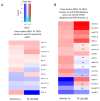A Mixture of Chemicals Found in Human Amniotic Fluid Disrupts Brain Gene Expression and Behavior in Xenopus laevis
- PMID: 36768911
- PMCID: PMC9916464
- DOI: 10.3390/ijms24032588
A Mixture of Chemicals Found in Human Amniotic Fluid Disrupts Brain Gene Expression and Behavior in Xenopus laevis
Abstract
Thyroid hormones (TH) are essential for normal brain development, influencing neural cell differentiation, migration, and synaptogenesis. Multiple endocrine-disrupting chemicals (EDCs) are found in the environment, raising concern for their potential effects on TH signaling and the consequences on neurodevelopment and behavior. While most research on EDCs investigates the effects of individual chemicals, human health may be adversely affected by a mixture of chemicals. The potential consequences of EDC exposure on human health are far-reaching and include problems with immune function, reproductive health, and neurological development. We hypothesized that embryonic exposure to a mixture of chemicals (containing phenols, phthalates, pesticides, heavy metals, and perfluorinated, polychlorinated, and polybrominated compounds) identified as commonly found in the human amniotic fluid could lead to altered brain development. We assessed its effect on TH signaling and neurodevelopment in an amphibian model (Xenopus laevis) highly sensitive to thyroid disruption. Fertilized eggs were exposed for eight days to either TH (thyroxine, T4 10 nM) or the amniotic mixture (at the actual concentration) until reaching stage NF47, where we analyzed gene expression in the brains of exposed tadpoles using both RT-qPCR and RNA sequencing. The results indicate that whilst some overlap on TH-dependent genes exists, T4 and the mixture have different gene signatures. Immunohistochemistry showed increased proliferation in the brains of T4-treated animals, whereas no difference was observed for the amniotic mixture. Further, we demonstrated diminished tadpoles' motility in response to T4 and mixture exposure. As the individual chemicals composing the mixture are considered safe, these results highlight the importance of examining the effects of mixtures to improve risk assessment.
Keywords: Xenopus laevis; endocrine disruption; neurodevelopment; thyroid hormones.
Conflict of interest statement
The authors declare no conflict of interest.
Figures








Similar articles
-
Human amniotic fluid contaminants alter thyroid hormone signalling and early brain development in Xenopus embryos.Sci Rep. 2017 Mar 7;7:43786. doi: 10.1038/srep43786. Sci Rep. 2017. PMID: 28266608 Free PMC article.
-
Thyroid Disrupting Chemicals in Mixture Perturb Thymocyte Differentiation in Xenopus laevis Tadpoles.Toxicol Sci. 2021 May 27;181(2):262-272. doi: 10.1093/toxsci/kfab029. Toxicol Sci. 2021. PMID: 33681995 Free PMC article.
-
Evaluation of gene expression endpoints in the context of a Xenopus laevis metamorphosis-based bioassay to detect thyroid hormone disruptors.Aquat Toxicol. 2006 Jan 5;76(1):24-36. doi: 10.1016/j.aquatox.2005.09.003. Epub 2005 Nov 9. Aquat Toxicol. 2006. PMID: 16289343
-
Neurodevelopmental impact of the offspring by thyroid hormone system-disrupting environmental chemicals during pregnancy.Environ Res. 2021 Sep;200:111345. doi: 10.1016/j.envres.2021.111345. Epub 2021 Jun 1. Environ Res. 2021. PMID: 34087190 Review.
-
Thyroid effects of endocrine disrupting chemicals.Mol Cell Endocrinol. 2012 May 22;355(2):240-8. doi: 10.1016/j.mce.2011.09.005. Epub 2011 Sep 10. Mol Cell Endocrinol. 2012. PMID: 21939731 Review.
Cited by
-
Intracytoplasmic Sperm Injection Using 20-Year-Old Cryopreserved Sperm Results in Normal, Viable, and Reproductive Offspring in Xenopus laevis: A Major Pioneering Achievement for Amphibian Conservation.Animals (Basel). 2025 Jul 1;15(13):1941. doi: 10.3390/ani15131941. Animals (Basel). 2025. PMID: 40646839 Free PMC article.
References
MeSH terms
Substances
Grants and funding
LinkOut - more resources
Full Text Sources
Molecular Biology Databases
Research Materials

